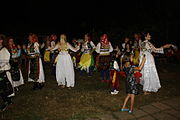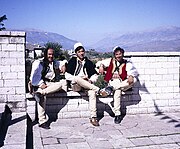Traditional Albanian clothing

Traditional Albanian clothing (Template:Country data veshjet tradicionale shqiptare, veshjet kombëtare, veshjet popullore ''ose'' kostumet kombëtare) includes more than 200 different kind of clothings in all Albania and Albanian inhabited lands. This is due to the division the Albanian principalities in the Middle Ages. The Albanian folk dress is often decorated with symbolic elements of antique pagan origin, like suns, eagles, moons, stars, and snakes.[1] Almost every region in Albania has its own traditional dress with women clothing being particularly colorful and rich in detail. Fabrics are traditionally made by weaving clothes using looms. To this day, some conservative old men and women mainly from the North wear traditional clothing in their daily lives. Instead, older women from the South usually wear all-black outfits.
Parts
The Albanian Dress consist of the following elements:

Headgear

Men
The following headdresses are in use for men:[2]
- Qeleshe [cɛˈlɛʃɛ] or Plis': a type of hat worn by men of Northern Albanian, Kosova, and parts of Montenegro and Macedonia inhabited by Albanians.This type of hat is very similar if not identical to the ancient Greek 'liberty' cap called Pileus, not only in shape, but obviously in etymology too (Ancient Greek 'Pilos', Albanian -'Plis').In central Albania (Tirana, Durrës, Kavaja) it is cone-shaped, and in North Albania and Kosovo round.
- Albanian hat (Template:Lang-fr)[3] worn typically during the 15th to 18th centuries[4] and immortalized in Onufri's paintings.
- Qylafë [ˈcylaf]: a woolen high hat worn in southern Albania.

For Women
The following headdress are in use for women:[5]
- Kapica [kaˈpitsa]: a headdress for women.
- Langi, other names include: peshqira, riza, marhamë, pashnik.
- Lëvere [ləˈvɛɾɛ]: right shaped headdress.
- Kryqe [ˈkɾycɛ]: square shaped headdress.
Pants and upper body covers
- Fustanella [fustaˈnɛɫa]: traditional skirt-like garment worn by men.
- Tirq [tiɾc]: long pant worn by man.
- Brekusha [bɾɛˈkuʃa]: for man and women.
- Xhubleta [dʒuˈblɛta]: Only worn by women.
- Mbështjellëse- Only worn by women.
Xhamadan
A Xhamadan is a traditional vest, which is worn by Albanian men throughout Albania, in Kosovo, the Republic of Macedonia, Serbia, Montenegro, and in the Arbëresh villages in Italy.
Brez
Brez are traditional belts, which are worn by Albanian men throughout Albania, in Kosovo, the Republic of Macedonia, Serbia, Montenegro, and in the Arbëresh villages in Italy.
Çorape
Çorape are traditional socks which are worn by Albanian men throughout Albania, in Kosovo, the Republic of Macedonia, Serbia, Montenegro, and in the Arbëresh villages in Italy.
Opinga
Opinga Albanian pronunciation: [ɔˈpiŋɡa]: (Art sandals), are traditional shoes which are worn by Albanian men throughout Albania, in Kosovo, the Republic of Macedonia, Serbia, Montenegro, and in the Arbëresh villages in Italy.
Style in different locations
South Albania
South Albania has many branches that come from many cities on the South.
Vlora
In the region of Vlora, the traditional costume for men is like the picture on the right. They use the Qeleshe cap. Then they wear a short black jacket, followed by a white shirt with wide sleeves. They also have a kind of a belt which is red and black like the Albanian Flag. They have black pants with long white socks. For shoes, they wear Opinga which are worn in Albania, Romania and Serbia. The costumes are very colorful.
Gallery
See also
- Arbëresh
- Fustanella
- Culture of Albania
- Gjirokastër National Folklore Festival
- Traditional clothing of Kosovo
- Albanian dances
References
- ^ Leyla Belkaid (2013), "Albania", in Jill Condra (ed.), Encyclopedia of National Dress: Traditional Clothing Around the World, vol. I, ABC-CLIO, p. 16, ISBN 9780313376368
- ^ Gjergji 2004: S. 191
- ^ de La Curne de Sainte-Palaye, Jean-Baptiste (1875). Dictionnaire historique de l'ancien langage françois (in French). Champion (T. 01-09). pp. 316–.
- ^ Anamali, Skënder (2002). Historia e popullit shqiptar në katër vëllime (in Albanian). Vol. I. Botimet Toena. p. 300. OCLC 52411919.
- ^ Gjergji 2004: S. 194
Further reading
- Andromaqi, Gjergj (2004). Albanian Costumes Through the Centuries: Origin, Types, Evolution. Mësonjëtorja. ISBN 978-99943-614-4-1.
- Andromaqi, Gjerjgi (1999). Albanian Folk Costumes. Instituti i Kulturës Popullore, Departamenti Etnologjisë. ISBN 978-99927-654-6-3.
External links
- Albanian Costumes at Albanian-Folklore.com
- Albanian Folk Costumes in Early Postcards
- Traditional Albanian Costumes Group on Flickr.com
- Infoarkiv: Etnografia e rrezikuar Template:Sq icon










